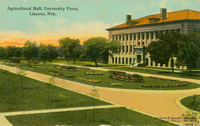Extension, Cooperative

Nebraska Agricultural Experiment Station: Historical Circulars
Date of this Version
7-1923
Document Type
Article
Citation
Swenk, M. H. (1923). The plains false wireworm and its control (University of Nebraska Agricultural Experiment Station Circular No. 20)
Abstract
The last three crops of winter wheat, and especially the crop of 1922-23, have been seriously injured in southwestern Nebraska and especially on the dry land farms of Cheyenne, Kimball, Banner, Morrill, Garden, Deuel , Keith, Perkins, and Hitchcock Counties, by an abundance of hard-bodied, cylindrical, shining waxy yellow, soil-infesting larvae. These greatly resemble wireworms and are often mistaken for them, but they differ conspicuously in being more active and having well-developed, club-shaped antennae, long and stout front legs, and a less flattened body with a distinctly upturned tip. These larvae destroy the planted seed in the fall and eat off the roots of the young plants both in the fall and in the spring. In some cases the damage done amounts to the practical ruination of the crop. This pest was undoubtedly no small factor in helping to cause the large acreage of abandoned wheat in the spring of 1923 in some of our western counties. It is known as the plains false wireworm (Eleodes opaca).


Comments
ISSN 0099-5460 (print)
ISSN 2690-8034 (online)